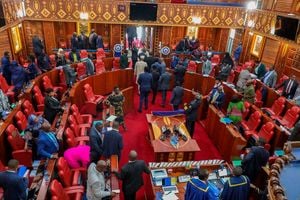Loopholes in Kenya's Sexual Offences Act leave room for abuse

The Sexual Offences Act has also been criticised for discriminating against boys.
What you need to know:
- Kenya's Sexual offences Act is "drafted to primarily punish the perpetrator without providing reparation for the survivor/victim".
- Many boys are languishing in jail for engaging in normal adolescent experiments while their female counterparts are not similarly punished.
Sexual offences in Kenya are principally addressed through the Sexual Offences Act, last amended in 2012. This law revolutionalised the perspective from which sexual offences were defined and included males among potential targets. It, however, has several limitations.
As pointed out by Connie Ngondi (2020) in Discriminatory laws against women and girls in Kenya, the Act is drafted to primarily punish the perpetrator without providing reparation for the survivor/victim.
Under rape, it defines “penetration” as “the partial or complete insertion of the genital organs of a person into (those) of another person”. Kiarie, WK (2007) correctly notes in “The Sexual Offences Act: Omissions and ambiguities” that this definition “assumes that a female’s genitalia can penetrate that of a male”, a physiological impossibility.
This loophole can be exploited technically to dismiss cases of women accused of rape. The Act also limits sexual harassment to contexts of employment, public offices, institutions of learning and places of custody. It also contextualises the definition to abuse of power, ignoring that even juniors can sexually harass their senior.
That most of the penalties are minimum rather than maximum sentences (sections 3, 5 and 6-15) denudes judicial officers of discretion hence, makes them superfluous in considering mitigating circumstances. Radical and liberal judicial officers have questioned the validity of such provisions and ignored them.
The Act has also been criticised for discriminating against boys. In the Daily Nation of April 20, 2021, Wangui, J and Njuguna S, noted that by virtue of this law, many boys are languishing in jail for engaging in normal adolescent experiments while their female counterparts are not similarly punished.
Sexual consent
Some courts have observed that where intercourse among minors is consensual, the girl is equally culpable hence, it is not fair to punish only the boy. Moreover, should minors be accused of and charged with engaging in what they do not have legal capacity to consent to?
The age of sexual consent was discussed in Parliament during debate on the Statute Law (Miscellaneous Amendments) Bill (2016). This Bill sought to lower the age from 18 to 16. The proposal was successfully opposed by women legislators who argued that it negated the definition of a child and would endanger girls.
The Act stipulates that when a “person” has intercourse with a minor, the sentence varies depending on the age of the child.
Three concerns arise. One, the word “person” does not distinguish between a minor and adult defiler. The inherent implication is that the sentence applies regardless of age, which compromises the best interests of the child.
Two, Section 8 (7) states that the court “may” sentence children in accordance with the Borstal Institutions Act (Cap. 92) and the Children’s Act (Cap. 141). This suggests that such recourse is a matter of choice, yet the cited laws are the principal statutes on children.
Favour perpetrators
Legal duality also arises where this law prescribes a sentence different from that in another statute for the same offence. For example, Section 14 of the Act prescribes minimum 10 years of imprisonment for promotion of child sex tourism. This is much lower than the 30 years minimum in the Counter-trafficking in Persons Act for the same offence The net effect is that cases which could be prosecuted under the latter can be shrewdly diverted to the former to favour perpetrators.
Contradictions also occur when the Act is applied in conjunction with other laws. For instance, the Criminal Procedure Code Chapter 75 dictates that evidence be taken in the presence of the accused person or his/her advocate during court proceedings. The Evidence Act (Chapter 80, sections 62 and 63) requires oral and direct testimonies. This means the accuser has to face the accused in court.
This contradicts the principle of protecting the identity of vulnerable witnesses, of which children are, and cushion them from stigma, as stated in Section 31 of the Sexual Offences Act.
Another problem concerns the survivor’s sexual history. Section 34 of the Act exempts the survivor’s character and sexual history from scrutiny and citation as evidence in a case. Yet the same section allows the magistrate to do exactly this on application by “any party to the proceedings”.
This leeway may be used by shrewd advocates to embarrass and intimidate the litigant hence weaken the case or have it determined based on extraneous circumstances.
The Sexual Offences Act also omits certain sexually offensive acts such as marital rape, sodomy, voyeurism, commission of sexual acts in public spaces and offences against lesbian, gay, bi-sexual, trans-sexual and inter-sex persons. Many other gaps were highlighted by Hon. Florence Mutua in the 11th parliament but her Bill was defeated.
Considering these lacunae, this law is ripe for comprehensive amendment.
The writer is an international gender and development consultant and scholar ([email protected]).





